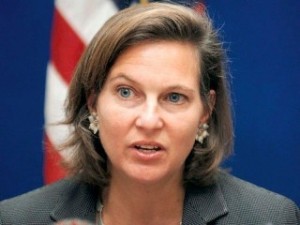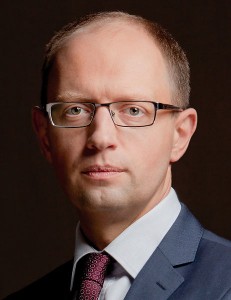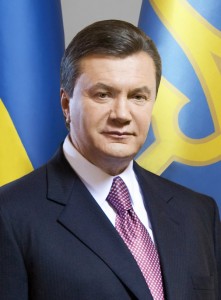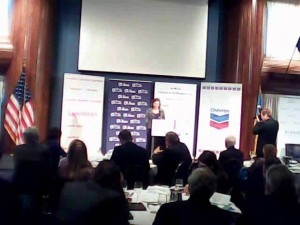The American Media Is A CIA Front
I reported honestly the facts of the US coup
that overthrew the elected Ukrainian government in 2014 (see my columns in
February and March 2014). However, the US print and TV media, led by the New
York Times, lied through their teeth.
Indeed, the “mainstream” US media functioned as
agent and propagandist for the Washington neoconservatives who destroyed
Ukrainian democracy and imposed massive suffering and death on Ukrainians.
There is no crime that the American
presstitutes will not commit and no lie that they will not tell.
‘Yats’ Is No Longer the Guy
April 11, 2016
Exclusive: Several weeks before Ukraine’s 2014 coup, U.S.
Assistant Secretary of State Nuland had already picked Arseniy Yatsenyuk to be
the future leader, but now “Yats” is no longer the guy, writes Robert Parry.
By Robert Parry
In reporting on the resignation of Ukrainian
Prime Minister Arseniy Yatsenyuk, the major U.S. newspapers either ignored or
distorted Assistant Secretary of State Victoria Nuland’s infamous intercepted phone call before the 2014 coup in which
she declared “Yats is the guy!”
Though Nuland’s phone call introduced many
Americans to the previously obscure Yatsenyuk, its timing – a few weeks
before the ouster of elected Ukrainian President Viktor Yanukovych – was never
helpful to Washington’s desired narrative of the Ukrainian people rising up on
their own to oust a corrupt leader.
Assistant Secretary of State for European
Affairs Victoria Nuland, who pushed for the Ukraine coup and helped pick the
post-coup leaders.
Instead, the conversation between Nuland and U.S.
Ambassador to Ukraine Geoffrey Pyatt sounded like two proconsuls picking which
Ukrainian politicians would lead the new government. Nuland also disparaged the
less aggressive approach of the European Union with the pithy put-down: “Fuck
the E.U.!”
More importantly, the intercepted call,
released onto YouTube in early February 2014, represented powerful
evidence that these senior U.S. officials were plotting – or at least
collaborating in – a coup d’etat against Ukraine’s democratically elected president.
So, the U.S. government and the mainstream U.S. media have since consigned this
revealing discussion to the Great Memory Hole.
On Monday, in reporting on Yatsenyuk’s Sunday
speech in which he announced that he is stepping down, The Washington Post and
The Wall Street Journal didn’t mention the Nuland-Pyatt conversation at all.
The New York Times did mention the call but
misled its readers regarding its timing, making it appear as if the call
followed rather than preceded the coup. That way the call sounded like two
American officials routinely appraising Ukraine’s future leaders, not plotting
to oust one government and install another.
The Times article by Andrew E. Kramer said: “Before Mr.
Yatsenyuk’s appointment as prime minister in 2014, a leaked recording of a
telephone conversation between Victoria J. Nuland, a United States assistant
secretary of state, and the American ambassador in Ukraine, Geoffrey R. Pyatt,
seemed to underscore the West’s support for his candidacy. ‘Yats is the
guy,’ Ms. Nuland had said.”
Ukraine’s Prime Minister Arseniy Yatsenyuk.
(Photo credit: Ybilyk)
Notice, however, that if you didn’t know that
the conversation occurred in late January or early February 2014, you wouldn’t
know that it preceded the Feb. 22, 2014 coup. You might have thought that it
was just a supportive chat before Yatsenyuk got his new job.
You also wouldn’t know that much of the
Nuland-Pyatt conversation focused on how they were going to “glue this thing”
or “midwife this thing,” comments sounding like prima facie evidence that the
U.S. government was engaged in “regime change” in Ukraine, on Russia’s
border.
The ‘No Coup’ Conclusion
But Kramer’s lack of specificity about the
timing and substance of the call fits with a long pattern of New York Times’
bias in its coverage of the Ukraine crisis. On Jan. 4, 2015, nearly a year
after the U.S.-backed coup, the Times published an “investigation” article
declaring that there never had been a coup. It was just a case of President
Yanukovych deciding to leave and not coming back.
That article reached its conclusion, in part,
by ignoring the evidence of a coup, including the Nuland-Pyatt phone call. The
story was co-written by Kramer and so it is interesting to know that he was at
least aware of the “Yats is the guy” reference although it was ignored in last
year’s long-form article.
Instead, Kramer and his co-author Andrew
Higgins took pains to mock anyone who actually looked at the evidence and dared
reach the disfavored conclusion about a coup. If you did, you were some
rube deluded by Russian propaganda.
“Russia has attributed Mr. Yanukovych’s
ouster to what it portrays as a violent, ‘neo-fascist’ coup supported and even
choreographed by the West and dressed up as a popular uprising,” Higgins and
Kramer wrote. “Few outside the Russian
propaganda bubble ever seriously entertained the Kremlin’s line. But almost a
year after the fall of Mr. Yanukovych’s government, questions remain about how
and why it collapsed so quickly and completely.”
The Times’ article concluded that Yanukovych
“was not so much overthrown as cast adrift by his own allies, and that Western
officials were just as surprised by the meltdown as anyone else. The allies’
desertion, fueled in large part by fear, was accelerated by the seizing by
protesters of a large stock of weapons in the west of the country. But just as
important, the review of the final hours shows, was the panic in government
ranks created by Mr. Yanukovych’s own efforts to make peace.”
Ousted Ukrainian President Viktor Yanukovych.
Yet, one might wonder what the Times thinks a
coup looks like. Indeed, the Ukrainian coup had many of the same earmarks as
such classics as the CIA-engineered regime changes in Iran in 1953 and in
Guatemala in 1954.
The way those coups played out is now
historically well known. Secret U.S. government operatives planted nasty
propaganda about the targeted leader, stirred up political and economic chaos,
conspired with rival political leaders, spread rumors of worse violence to come
and then – as political institutions collapsed – watched as the scared
but duly elected leader made a hasty departure.
In Iran, the coup reinstalled the
autocratic Shah who then ruled with a heavy hand for the next quarter century;
in Guatemala, the coup led to more than three decades of brutal military
regimes and the killing of some 200,000 Guatemalans.
Coups don’t have to involve army tanks
occupying the public squares, although that is an alternative model which
follows many of the same initial steps except that the military is brought in
at the end. The military coup was a common approach especially in Latin America
in the 1960s and 1970s.
‘Color Revolutions’
But the preferred method in more recent years
has been the “color revolution,” which operates behind the façade of a
“peaceful” popular uprising and international pressure on the targeted leader
to show restraint until it’s too late to stop the coup. Despite
the restraint, the leader is still accused of gross human rights
violations, all the better to justify his removal.
Later, the ousted leader may get an image
makeover; instead of a cruel bully, he is ridiculed for not showing sufficient
resolve and letting his base of support melt away, as happened with
Mohammad Mossadegh in Iran and Jacobo Arbenz in Guatemala.
But the reality of what happened in Ukraine was
never hard to figure out. Nor did you have to be inside “the Russian
propaganda bubble” to recognize it. George Friedman, the founder of the global
intelligence firm Stratfor, called Yanukovych’s
overthrow “the most blatant coup in history.”
Which is what it appears if you consider the
evidence. The first step in the process was to create tensions around the issue
of pulling Ukraine out of Russia’s economic orbit and capturing it in the
European Union’s gravity, a plan defined by influential American neocons in
2013.
On Sept. 26, 2013, National Endowment for
Democracy President Carl Gershman, who has been a major neocon paymaster for
decades, took to the op-ed page of the neocon Washington Post and called
Ukraine “the biggest prize” and an important interim step toward toppling
Russian President Vladimir Putin.
At the time, Gershman, whose NED is funded by
the U.S. Congress to the tune of about $100 million a year, was financing
scores of projects inside Ukraine training activists, paying for journalists
and organizing business groups.
As for the even bigger prize — Putin — Gershman
wrote: “Ukraine’s choice to join Europe will accelerate the demise of the
ideology of Russian imperialism that Putin represents. Russians, too, face a
choice, and Putin may find himself on the losing end not just in the near
abroad but within Russia itself.”
At that time, in early fall 2013, Ukraine’s
President Yanukovych was exploring the idea of reaching out to Europe with an
association agreement. But he got cold feet in November 2013 when economic
experts in Kiev advised him that the Ukrainian economy would suffer a $160
billion hit if it separated from Russia, its eastern neighbor and major trading
partner. There was also the West’s demand that Ukraine accept a harsh austerity
plan from the International Monetary Fund.
Yanukovych wanted more time for the E.U.
negotiations, but his decision angered many western Ukrainians who saw their
future more attached to Europe than Russia. Tens of thousands of protesters
began camping out at Maidan Square in Kiev, with Yanukovych ordering the police
to show restraint.
Meanwhile, with Yanukovych shifting back toward
Russia, which was offering a more generous $15 billion loan and discounted
natural gas, he soon became the target of American neocons and the U.S. media,
which portrayed Ukraine’s political unrest as a black-and-white case of a
brutal and corrupt Yanukovych opposed by a saintly “pro-democracy” movement.
Cheering an Uprising
The Maidan uprising was urged on by American
neocons, including Assistant Secretary of State for European Affairs Nuland,
who passed out cookies at the Maidan and reminded Ukrainian business leaders
that the United States had invested $5 billion in their “European aspirations.”
A screen shot of U.S. Assistant Secretary of
State for European Affairs Victoria Nuland speaking to U.S. and Ukrainian
business leaders on Dec. 13, 2013, at an event sponsored by Chevron, with its
logo to Nuland’s left.
Sen. John McCain, R-Arizona, also showed up,
standing on stage with right-wing extremists from the Svoboda Party and telling
the crowd that the United States was with them in their challenge to the
Ukrainian government.
As the winter progressed, the protests grew
more violent. Neo-Nazi and other extremist elements from Lviv and other western
Ukrainian cities began arriving in well-organized brigades or “sotins” of 100
trained street fighters. Police were attacked with firebombs and other weapons
as the violent protesters began seizing government buildings and unfurling Nazi
banners and even a Confederate flag.
Though Yanukovych continued to order his police
to show restraint, he was still depicted in the major U.S. news media as a
brutal thug who was callously murdering his own people. The chaos reached a
climax on Feb. 20 when mysterious snipers opened fire, killing both police
and protesters. As the police retreated, the militants advanced brandishing
firearms and other weapons. The confrontation led to significant loss of life,
pushing the death toll to around 80 including more than a dozen police.
U.S. diplomats and the mainstream U.S. press
immediately blamed Yanukovych for the sniper attack, though the circumstances
remain murky to this day and some investigations have suggested that the lethal
sniper fire came from buildings controlled by Right Sektor extremists.
To tamp down the worsening violence, a shaken
Yanukovych signed a European-brokered deal on Feb. 21, in which he accepted
reduced powers and an early election so he could be voted out of office. He
also agreed to requests from Vice President Joe Biden to pull back the police.
The precipitous police withdrawal opened
the path for the neo-Nazis and other street fighters to seize presidential
offices and force Yanukovych and his officials to flee for their lives. The new
coup regime was immediately declared “legitimate” by the U.S. State Department
with Yanukovych sought on murder charges. Nuland’s favorite, Yatsenyuk, became
the new prime minister.
Throughout the crisis, the mainstream U.S.
press hammered home the theme of white-hatted protesters versus a black-hatted
president. The police were portrayed as brutal killers who fired on unarmed
supporters of “democracy.” The good-guy/bad-guy narrative was all the American
people heard from the major media.
The New York Times went so far as to delete the
slain policemen from the narrative and simply report that the police had killed
all those who died in the Maidan. A typical Times report on March 5, 2014,
summed up the storyline: “More than 80 protesters were shot to death by the
police as an uprising spiraled out of control in mid-February.”
The mainstream U.S. media also sought to
discredit anyone who observed the obvious fact that an unconstitutional coup
had just occurred. A new theme emerged that portrayed Yanukovych as simply
deciding to abandon his government because of the moral pressure from the noble
and peaceful Maidan protests.
Any reference to a “coup” was dismissed as
“Russian propaganda.” There was a parallel determination in the U.S. media to
discredit or ignore evidence that neo-Nazi militias had played an important
role in ousting Yanukovych and in the subsequent suppression of anti-coup
resistance in eastern and southern Ukraine. That opposition among
ethnic-Russian Ukrainians simply became “Russian aggression.”
Nazi symbols on helmets worn by members of
Ukraine’s Azov battalion. (As filmed by a Norwegian film crew and shown on
German TV)
This refusal to notice what was actually a
remarkable story – the willful unleashing of Nazi storm troopers on a European
population for the first time since World War II – reached absurd levels as The
New York Times and The Washington Post buried references to the neo-Nazis at
the end of stories, almost as afterthoughts.
The Washington Post went to the extreme of
rationalizing Swastikas and other Nazi symbols by quoting one militia
commander as calling them “romantic” gestures by impressionable young men. [See
Consortiumnews.com’s “Ukraine’s ‘Romantic’ Neo-Nazi Storm
Troopers.”]
But today – more than two years after what U.S.
and Ukrainian officials like to call “the Revolution of Dignity” – the
U.S.-backed Ukrainian government is sinking into dysfunction, reliant on
handouts from the IMF and Western governments.
And, in a move perhaps now more symbolic than
substantive, Prime Minister Yatsenyuk is stepping down. Yats is no longer the
guy.
Investigative reporter Robert Parry broke many
of the Iran-Contra stories for The Associated Press and Newsweek in the 1980s.
You can buy his latest book, America’s Stolen Narrative.












/https://www.niagarafallsreview.ca/content/dam/thestar/news/canada/2021/09/25/huawei-executive-meng-wanzhou-receives-warm-welcome-upon-return-to-china/_1_meng_wanzhou_2.jpg)

No comments:
Post a Comment
Note: Only a member of this blog may post a comment.